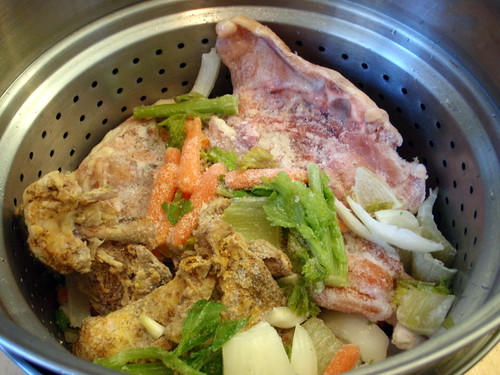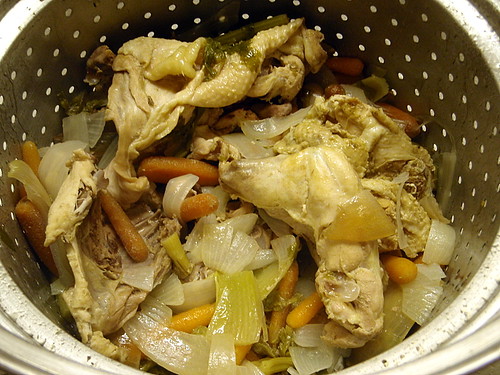1. Save vegetable scraps for stock. I had some leftover celery and carrots from making the clam chowda and extra onion left from making roast chicken which I threw in a freezer bag until I was ready to make the stock.
2. Use the pasta strainer insert. A great way to remove the carcass and vegetables after the stock is done without having to awkwardly dump everything into a strainer. You still have to strain the stock, but it's a lot easier without the huge carcass in the way.
Homemade Chicken Stock (based on this recipe)
makes 6 quarts
Chicken carcass or 4 chicken breast carcasses (preferably with a little meat left on it)
A handful or two each of onions, carrots, and celery
Bay leaf
Peppercorns
Garlic cloves
Pull apart whatever is left of the chicken carcass. It's good to split small bones apart; this helps the stock jell. Cut up one or two onions, a few stalks of celery, and a couple carrots and pile into the pasta insert of a large pot with the chicken pieces. Add a bay leaf, a few peppercorns, a couple of garlic cloves, and any other wilting greens you have around - leeks and turnips are good too.
Fill the pot with water, cover, and put over high heat.
Bring to a rolling boil then lower the heat. You don't want this to boil briskly; the water should just gurgle, with a few bubbles occasionally hitting the surface.
If a foamy muck comes to the top, skim it off. This is just fat rising to the surface. Don't worry if you can't get all of it. Let simmer for about four hours - or however long you have. Two hours will produce a reasonably good chicken stock, although it is not ideal.
Once the stock is done, remove from heat. Remove the pasta insert and drain. Carefully ladle stock through a sieve into storage containers, pouring it out once it is at a manageable volume.
If it is cold outside, set the containers of stock outside to chill; otherwise, let cool to room temperature and then transfer to refrigerator to chill.
Once it has chilled, skim off the fat from the top of the stock. The stock will keep in the fridge for a few days and in the freezer for a few months.
If you don't feel like your stock has enough body, you can reduce it in volume by boiling it until you get it to where you want it. Whatever you do, do not add salt to your stock. That should be done when you are making your soup; you can always add salt to a soup but there's no way to save an over-salted soup.Next up: Potato Leek Soup with Bacon












I've started doing this too... I figure why wasted the bones when I make chicken :)
ReplyDelete